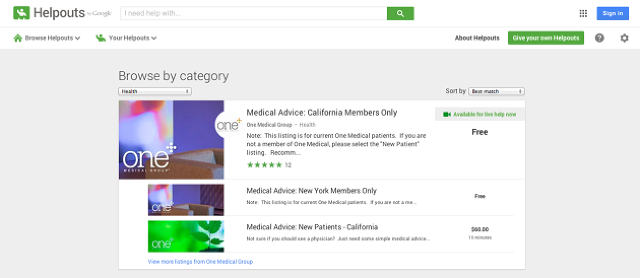- aligned with US DHHS
- doesn’t support third party payments
- asynchronous comms allows more convenience
- pricing is pitched at co-pay levels
- various other services discussed
THE DOCTOR, VETERINARIAN, AND LACTATION SPECIALIST WILL SEE YOU NOW–ON VIDEO CHAT
WITH SERVICES LIKE GOOGLE HELPOUTS, HOUSE CALLS ARE BACK IN A BIG, MODERN WAY.
When Google launched Helpouts in November, it opened a marketplace for experts–from scrappy entrepreneurs to big-name brands such as makeup retailer Sephora–to share their skills over video chat.
Now, while some clueless consumers are simply looking for mascara tips, the search giant sees a vastly different industry that can benefit from the service: health care.
That’s right, in addition to the many musicians, yogis, and IT pros chatting on the Helpouts platform, there are also doctors, counselors, veterinarians, and lactation specialists, among other medical professionals. By melding parts of its infrastructure–namely Google Wallet and Hangouts–the company gives consumers a single destination, either through a computer or Android phone, to book sessions with experts and to pay for them. Doctors can even prescribe medicine, as Helpouts is aligned with the U.S. Department of Health and Human Services.
“We believe telehealth, and Helpouts, can complement in-person office appointments and play an important part in the overall continuum of care,” Google’s director of business operations, Christina Wire, tells Fast Company. “We look forward to learning how users find Helpouts to be most helpful in their continuum of care.”
Telemedicine isn’t exactly a new concept. Defined very broadly, the term can be applied to, say, African villagers who used smoke signals to warn others of disease outbreaks. More contemporary forms of telemedicine include the use of Xbox to care for patients with chronic illnesses and telepresence robots, such as the human-sizedRP-VITA from iRobot that lets doctors interact with patients from afar. But with the advent of mobile technologies, telemedicine has the potential to go mainstream.
Using Helpouts, San Francisco resident Justine Lam, 34, consulted One Medical Groupabout getting a flu shot while traveling in Austin early November. The first time she connected, the picture was fuzzy and the call dropped, but the second time, she got a hold of a nurse practitioner, who coincidentally happened to be the one she usually interacts with.
“I travel a lot for work, so it’s difficult for me to get to the doctor’s office,” says Lam, who formerly worked in marketing and recruiting for a tech company. “It was super easy. I just log in, find the time available, and within an hour I was seeing a medical professional.”

One Medical provides its services over Hangouts at no cost to its members; it charges non-members $40 to $60 per session. Dr. Kevin Fell is one of the staff members who now works a weekly shift where he’s on Helpouts duty. “Surprisingly, it feels very personal,” he says. “It feels like being a country doctor and making a really personal house call with the help of modern technology.”
Technology, Fell notes, may not quite replace humans just yet: “I still think the one-on-one physical meeting with a patient is still very important–always has been, always will be.”
Patients like Lam are turning to online platforms for less severe illnesses. And some providers are keen on servicing Telecure, a company focused on providing virtual urgent care. It joined Helpouts in November and only sees patients if they meet certain criteria. For example, they can’t have a fever exceeding 103 degrees or be sick for more than two weeks.
But there are also online platforms that aim to provide medical help beyond the common cold. Grand Rounds was cofounded by a blood clot specialist focused on cutting-edge advances in medicine, the type of treatment that on average takes 17 years to trickle into medical practices. “That’s been the bane of my existence,” cofounder Rusty Hofmann says. “I felt ethically compelled to start this company to fix this problem. The work that I do on blood clots was developed at Stanford in 1992, and 15 years later there were still hospitals 10 minutes away from Stanford not offering this treatment.”

Using the web, patients are able to consult with specialists, who review their medical history, imaging, lab tests, and other information before writing a four-page opinion describing the best course of action. Grand Rounds’ efficiency, Hofmann says, is dependent on asynchronous communication, allowing patients and doctors to use the platform without having to coordinate schedules while also giving doctors the time to research patients’ conditions.
One of the biggest obstacles standing in the way of broader telemedicine adoption is a familiar force: insurance companies. While President Obama hopes telemedicine can help reduce health care costs, the Affordable Care Act doesn’t go so far as to require insurers to pay for remote consultations. “Helpouts does not have a system in place to submit sessions to health insurance plans for reimbursement,” says Google’s Wire. “Reimbursement for Helpouts sessions is at the discretion of the health provider and the health plans they work with.”
Pearl.com, a 10-year-old online marketplace that started with a health care vertical, has tried to involve insurance providers for years. “We would love it if insurance companies would cover online doctors and telehealth,” says CEO and founder Andy Kurtzig, noting the site hit a major milestone in November with experts earning $100 million to date. “We would touch base once in a while, and the answer’s always no.”

Virtual health care companies try to make up for the lack of insurance coverage by pricing their services comparable to copays. Across the board, Pearl.com sessions begin at $15 and average about $30. Telecure prices its 15-minute sessions at a flat $25, and most consultations don’t exceed that, says CEO Garick Hismatullin. The company, in part because it doesn’t have an advertising budget, also added a way for patients to pay for their services with tweets–“social currency,” Hismatullin says. “We were looking for a way to make people more aware of our service,” he says, mentioning the pay-by-tweet option is available only on its site, not Helpouts. “This was a direct result of us watching thousands of incredibly satisfied patients, to let them do the talking for our company instead of paying for advertising.”
Helpouts is playing a role in hastening telemedicine’s adoption, but changes take time. “Services like Helpouts have the power to bring back doctor house visits after 50 years,” says Google’s Wire.
There will always be reason to physically go to a doctor’s office, but One Medical’s Fell is amazed at technology’s potential to transform health care. He recalls being at Mayo Medical School in the early ’90s and first hearing about telemedicine. “There was a doctor who said, ‘When you guys are older and in practice, you’re going to be able to see and meet with patients wherever they are, wherever you are,'” Fell remembers. “Most of us at the time, we didn’t even have an email address.”
[Base Images: Flickr users Phalinn Ooi & Official U.S. Navy]